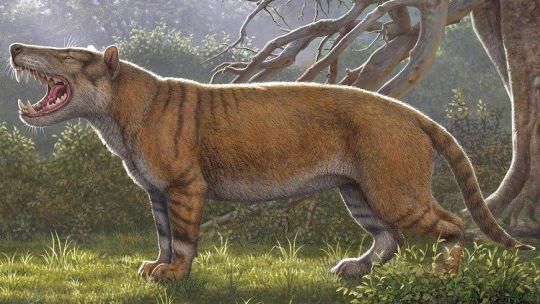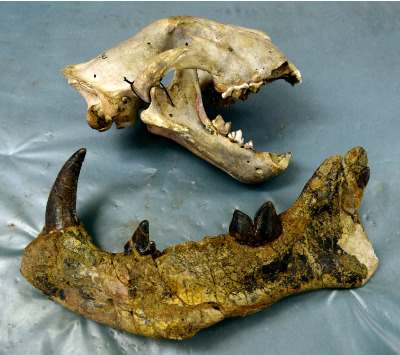#hyeanodont
Text


October's Fossil of the Month - Simbakubwa (Simbakubwa kutokaafrika)
Family: Hyena Cat Family (Hyainailouridae)
Time Period: 23-22 Million Years Ago (Early Neogene)
Currently known only from fossilised teeth and lower jaws discovered in Kenya's Messa Bridge fossil site, Simbakubwa kutokaaffrika was originally described as a prehistoric species of hyena before reexamination of fossils housed at the Nairobi National Museum of Kenya led to it being reclassified as a hyaenadont (a member of the extinct order Hyaenadonta, the members of which were generally dog-like animals with similar jaws and teeth to modern hyenas, although their teeth differed from true carnivorans today in that they lacked modified molars used for crushing and tearing seen in animals such as bears and dogs, and seemed to grow their teeth in slower than most modern carnivores.) While the limited variety of Simbakubwa fossils means that much of its biology is a mystery, it is notable among the hyaenadonts because of its size; estimates of its body size based on the size of its jaws suggest that, while most hyaenodonts were comparable to a large dog in size, it was at least as large as a lion, with the most generous estimates suggesting that it may have weighed as much as 1,500kg/3,307lbs (surpassing even modern Polar Bears in size,) although as the more complete fossils of related species suggest that members of the "hyena-cat" family of hyaenodonts that Simbakubwa belonged to had extremely large heads compared to their bodies it is unlikely that it actually reached such as size. Based on the shape of its teeth and the presumed strength of its jaws it is likely that Simbakubwa was purely carnivorous and fed on large mammals such as rhinoceros and gomphotheres (extinct relatives of modern elephants,) although based on the lack of any preserved teeth showing adaptations for crushing it is unclear if members of this species also fed on bones as other hyaenodonts and modern hyenas are known to do. While the circumstances of Simbakubwa's extinction are unclear, it is plausible that as the earth gradually became cooler and drier as it approached a series of "ice ages" in the later neogene resources became scarcer and large carnivores were among the first species to be affected by this. While the binomial names of most species are derived from Greek and/or Latin, Simbakubwa kutokaaffrika is Swahili, translating roughly to "great lion from Africa."
--------------------------------------------------------------------------
*Note - The second image above shows a Simbakubwa lower jaw (bottom) compared to a modern Lion skull (top.)
Image Sources: https://commons.wikimedia.org/wiki/File:Simbakubwa-kutokaafrika_2.jpg
and
https://www.nationalgeographic.com/science/article/new-species-ancient-carnivore-was-bigger-than-polar-bear-hyaenodonts
#Simbakubwa#hyeanodont#hyaenodonts#zoology#biology#paleontology#mammalogy#prehistoric wildlife#animal#animals#wildlife#African wildlife#African fossils#fossil#fossils#mammal#mammals#prehistoric animals#prehistoric mammals
245 notes
·
View notes